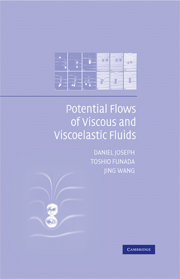Book contents
- Frontmatter
- Contents
- Preface
- List of Abbreviations
- 1 Introduction
- 2 Historical notes
- 3 Boundary conditions for viscous fluids
- 4 Helmholtz decomposition coupling rotational to irrotational flow
- 5 Harmonic functions that give rise to vorticity
- 6 Radial motions of a spherical gas bubble in a viscous liquid
- 7 Rise velocity of a spherical cap bubble
- 8 Ellipsoidal model of the rise of a Taylor bubble in a round tube
- 9 Rayleigh–Taylor instability of viscous fluids
- 10 The force on a cylinder near a wall in viscous potential flows
- 11 Kelvin–Helmholtz instability
- 12 Energy equation for irrotational theories of gas–liquid flow: viscous potential flow, viscous potential flow with pressure correction, and dissipation method
- 13 Rising bubbles
- 14 Purely irrotational theories of the effect of viscosity on the decay of waves
- 15 Irrotational Faraday waves on a viscous fluid
- 16 Stability of a liquid jet into incompressible gases and liquids
- 17 Stress-induced cavitation
- 18 Viscous effects of the irrotational flow outside boundary layers on rigid solids
- 19 Irrotational flows that satisfy the compressible Navier–Stokes equations
- 20 Irrotational flows of viscoelastic fluids
- 21 Purely irrotational theories of stability of viscoelastic fluids
- 22 Numerical methods for irrotational flows of viscous fluid
- Appendix A Equations of motion and strain rates for rotational and irrotational flow in Cartesian, cylindrical, and spherical coordinates
- Appendix B List of frequently used symbols and concepts
- References
- Index
10 - The force on a cylinder near a wall in viscous potential flows
Published online by Cambridge University Press: 09 October 2009
- Frontmatter
- Contents
- Preface
- List of Abbreviations
- 1 Introduction
- 2 Historical notes
- 3 Boundary conditions for viscous fluids
- 4 Helmholtz decomposition coupling rotational to irrotational flow
- 5 Harmonic functions that give rise to vorticity
- 6 Radial motions of a spherical gas bubble in a viscous liquid
- 7 Rise velocity of a spherical cap bubble
- 8 Ellipsoidal model of the rise of a Taylor bubble in a round tube
- 9 Rayleigh–Taylor instability of viscous fluids
- 10 The force on a cylinder near a wall in viscous potential flows
- 11 Kelvin–Helmholtz instability
- 12 Energy equation for irrotational theories of gas–liquid flow: viscous potential flow, viscous potential flow with pressure correction, and dissipation method
- 13 Rising bubbles
- 14 Purely irrotational theories of the effect of viscosity on the decay of waves
- 15 Irrotational Faraday waves on a viscous fluid
- 16 Stability of a liquid jet into incompressible gases and liquids
- 17 Stress-induced cavitation
- 18 Viscous effects of the irrotational flow outside boundary layers on rigid solids
- 19 Irrotational flows that satisfy the compressible Navier–Stokes equations
- 20 Irrotational flows of viscoelastic fluids
- 21 Purely irrotational theories of stability of viscoelastic fluids
- 22 Numerical methods for irrotational flows of viscous fluid
- Appendix A Equations of motion and strain rates for rotational and irrotational flow in Cartesian, cylindrical, and spherical coordinates
- Appendix B List of frequently used symbols and concepts
- References
- Index
Summary
We study the force on a 2D cylinder near a wall in two potential flows: the flow that is due to the circulation 2πκ about the cylinder and the uniform streaming flow with velocity V past the cylinder. The pressure is computed with Bernoulli's equation, and the viscous normal stress is calculated with VPF; the shear stress is ignored. The forces on the cylinder are computed by integration of the normal stress over the surface of the cylinder. In both of the two cases, the force perpendicular to the wall (lift) is due to only the pressure and the force parallel to the wall (drag) is due to only the viscous normal stress. Our results show that the drag on a cylinder near a wall is larger than on a cylinder in an unbounded domain. In the flow induced by circulation or in the streaming flow, the lift force is always pushing the cylinder toward the wall. However, when the two flows are combined, the lift force can be pushing the cylinder away from the wall or toward the wall.
The flow that is due to the circulation about the cylinder
Figure 10.1 shows a cylinder with radius a near the wall x = 0.
- Type
- Chapter
- Information
- Potential Flows of Viscous and Viscoelastic Liquids , pp. 90 - 99Publisher: Cambridge University PressPrint publication year: 2007

